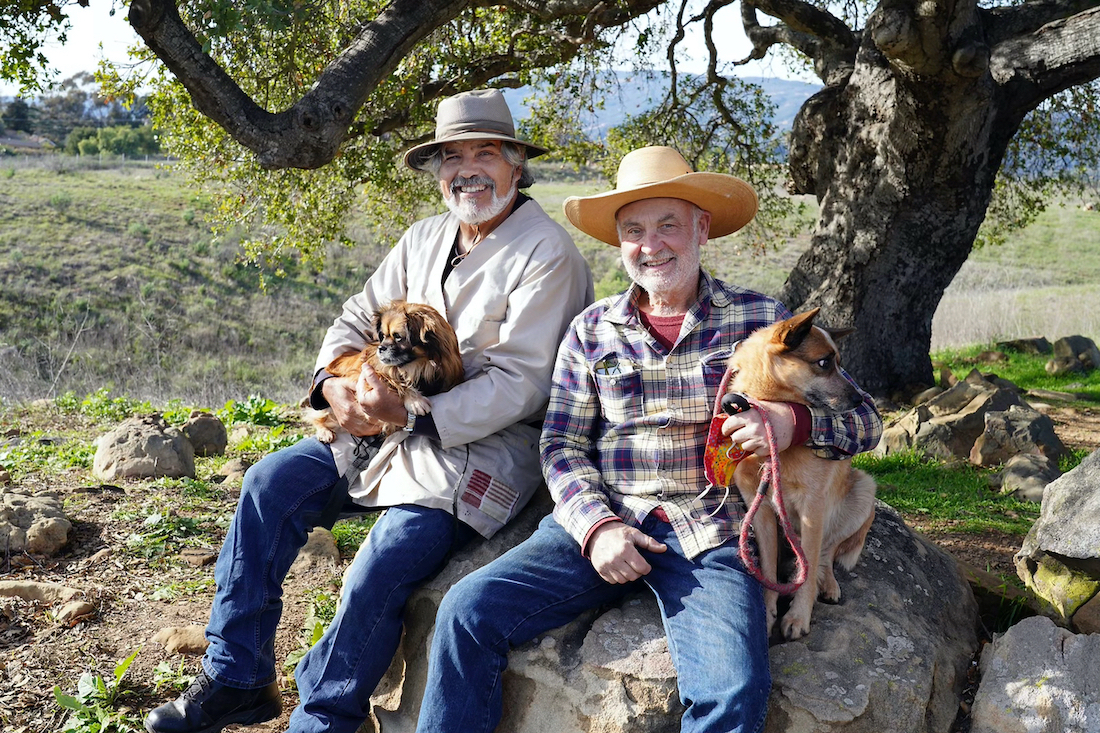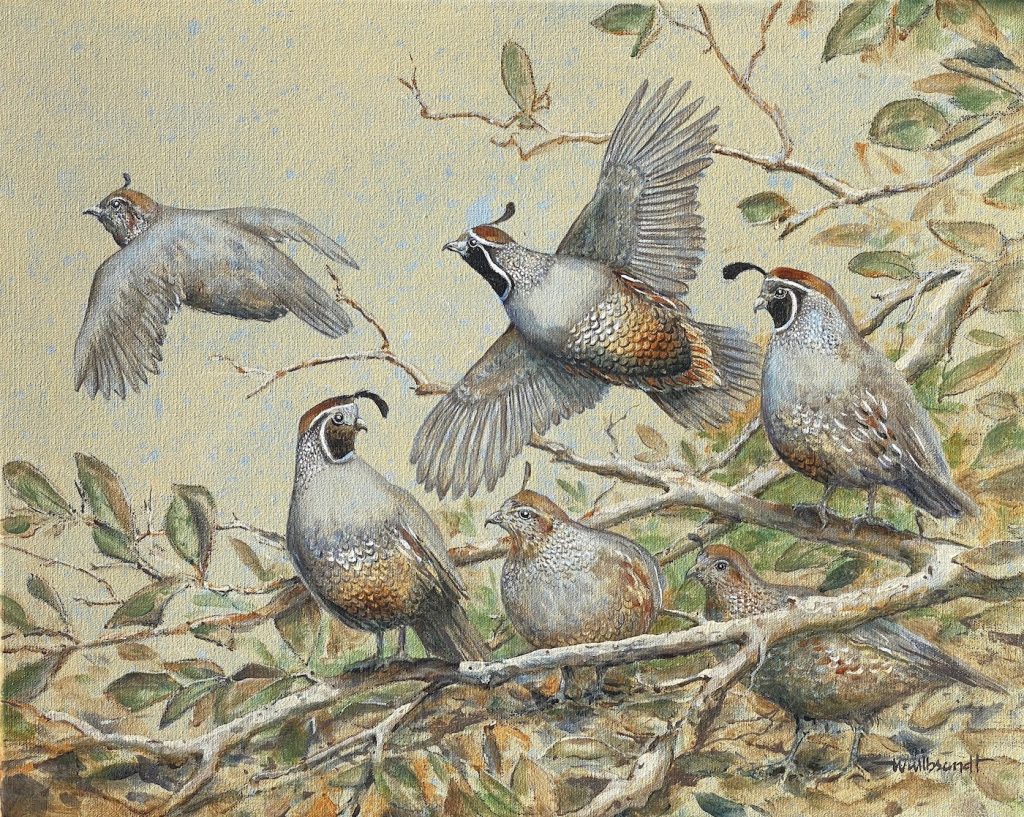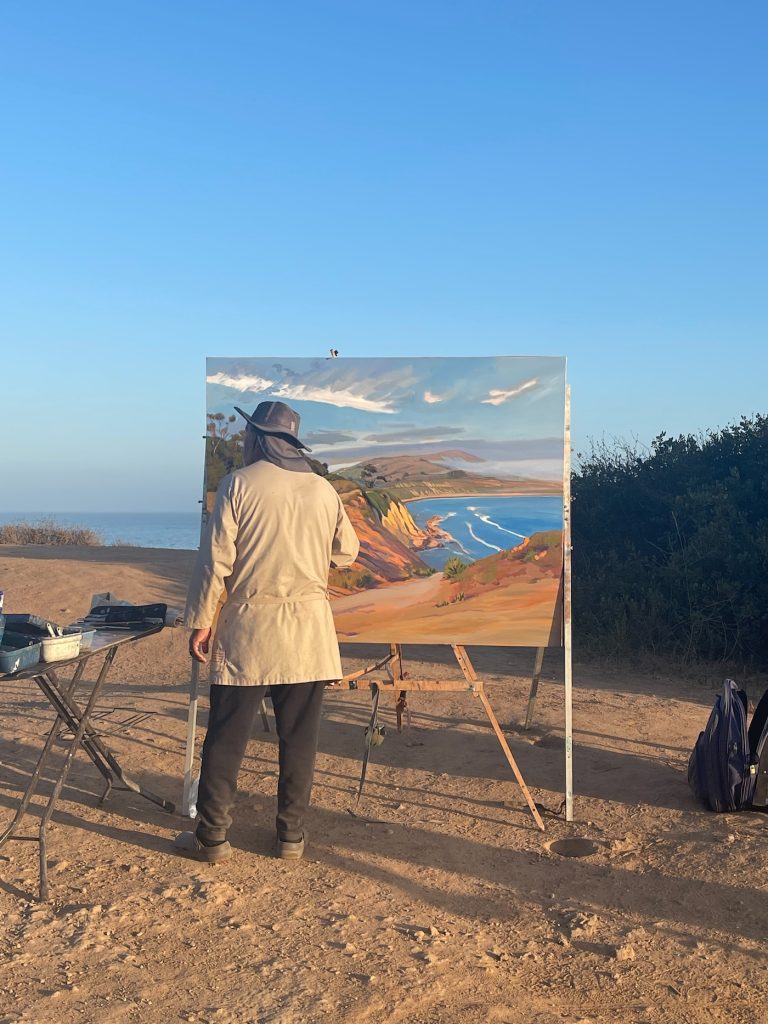Rooted in Art: ‘Dos Arbolitos’ Exhibit Paints a Picture of Friendship and Nature

If a picture is worth a thousand words, then it was a photo that inspired a thousand (or so) paintings when the Oak Group gathered under an expansive eponymous tree along the San Marcos Foothill Preserve 35 years ago for a photo. Founded on the idea of painting the places of nature in an effort to draw attention to their environmental risks of these same spaces, the Oak Group has gone on to grow into a collective force of plein air paintings and environmentalism.
The group was originally cofounded by painters and activists, Arturo Tello and Ray Strong, back in December of 1985. Through its 35-year history, the Oak Group has grown to 25 active members with over 100 exhibitions that have benefited more than 20 nonprofit conservation organizations and whose sales to date of $3 million have supported open space preservation.

More recently, they came together again to recreate that same portrait, once more taken by esteemed photographer and fellow Oak member, Bill Dewey; this time, unfortunately, sans their cofounder Ray Strong, but with John Wullbrandt sitting in his place (and a similar looking profile).
It was the setting of this image where the idea of a two-person show between Arturo and John really took root. While meeting for the photo, Julie Morgan, who runs Santa Barbara Fine Art Gallery alongside husband and renowned Oak Group artist, Richard Schloss, had previously discussed the idea of Arturo and John doing a show together, but it was in front of this legendary oak tree that Arturo thought of the exhibit’s name: Dos Arbolitos (‘Two Little Dear Trees’).
While the Linda Ronstadt song of the same title didn’t directly inspire the name, for Arturo, its lyrics did provide some meaning and inspiration along the way. But largely, the title is a symbol of their deep roots in Carpinteria, long friendship together, and the group’s influence along the way. Arturo, who also owns Palm Loft Gallery in Carpinteria, adds, “John and I are interested in being a solid root for the community, branching out, and just being a resource for community. And so that’s part of the symbolism of this.”
The resulting exhibit, Dos Arbolitos, opened on September 1 at the Santa Barbara Fine Art Gallery and will be up until November 27. The show offers around a dozen new paintings each from John and Arturo that span their own particular style and take on the subject, while also referencing the impact of the artists and Oak Group.
While developing the show, there was a natural inclination towards inviting other Oak members, but despite the desire to have their friends join in, John and Arturo decided to stick to the idea of just keeping it to the two of them. Both
artists note that a two-person show is fairly uncommon and has a different dynamic than solo or group shows.
Two Trees, Two Painters
For John, these days he will rarely go out and paint in plein air, working primarily in acrylics, which are more difficult to work with in the open environment. He uses lots of drawings and photographs to preserve the images he hopes to paint. Over the years, his works have scaled from delicate miniatures to full-sized murals, with two pieces in Dos Arbolitos being larger than five feet wide. He also notes that he has never painted in one style or subject matter.
This time around, John chose to focus his brush on the animals and strokes of life around his Carpinteria ranch property. With about half of the paintings centered on the surrounding fauna, these works capture the graceful soar of a red-tailed hawk or the weariness of Dos Burros after a day’s work (one assumes).

In John Deere Green, a lone tractor stands, almost proud yet forgotten, surrounded by windswept grass and its top linework fading into the hillside behind it. The seat, steering wheel, and other mechanical parts break the eyeline as if trying to be remembered.
For Dos Arbolitos, John did paint some other landscapes, including a tree scene, Crossing Paths, that he can see from his kitchen window. This particular one he has painted before, “but this time I painted it so that it emphasizes the path,” John adds, “I thought, kind of a subtle reference to the fact that Arturo and I have paths that cross, and so at this show our paths are crossing again.” This site and its surroundings being where John and Arturo originally met, 38 years ago or so, when Arturo, a young activist at the time, was taken there by John’s father, Ernie Wullbrandt, a city councilman and later Mayor of Carpinteria.
Now, years later and after an extensive history with both painting and activism, Arturo continues to work in the traditional form of plein air paintings, mentioning that he practically lives in his van while working so that he can paint on location. As he approaches each painting, Arturo seeks to capture an “intimacy with my surroundings, nature, and close environment.” He chose to paint many of the locations in his Carpinteria ‘backyard’ for this show, a setting that often inspires him and finds its way into his works.
Arturo has a background in figure painting, and although he no longer actively paints in this particular discipline, its influence can be seen throughout his works. Trees will stretch out their limbs in the morning sun; hills and waves roll through the composition with bodily curves. Many of his works have a moody palette – shadow swept vistas often receiving a dash of the evening’s last light. These works seem to express what the landscape is feeling and its movement over time, often featuring elements of light that hit surfaces and reveal the life underneath the strokes of color. In Tar Pits Park in Fog, a somber, foggy tar pit coastline is belied by the vibrant greens of the hillside and softened by the periwinkle skies.
He chose to take the Dos Arbolitos theme more literally for this exhibit, the majority of the pieces highlighting one or more trees in them. In one of his key works for the show, Landmark Cypress, Tar Pits Park, Carpinteria, the distinct cypress stands prominent, nearly spanning the height of the canvas, its impact amplified by the scale of the other cypresses around it. There are two paintings that feature the “Tenacity Tree,” which has become a memorial and symbol for his mother, standing near where he and a friend paddled out his mother’s ashes upon her passing. He notes, “What is wonderful about that tree is that it looks completely dead, but it’s actually quite alive. And the part that is alive is a big branch that goes and reaches down to the beach.” He added that if the branch was upright, the tree would be standing as tall as the landmark cypress.
And just like their friendship with each other and the other members of the Oak Group, these relationships, rooted in history and a mutual love for the natural world, continue to grow with each day, painting, and even the occasional photograph.
See Dos Arbolitos at Santa Barbara Fine Art Gallery (1321 State Street) or visit santabarbarafineart.com for more
information.







You must be logged in to post a comment.